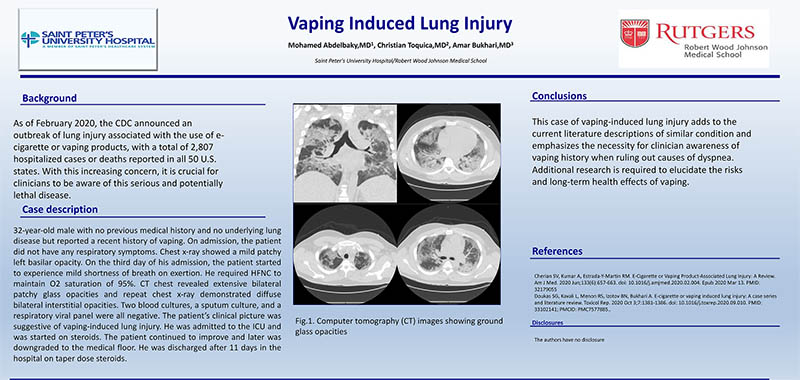
Hover to pan and click to magnify. Click again to pan at full screen.
Mohamed Abdelbaky,MD1, Christian Toquica,MD2, Amar Bukhari,MD3
Mohamed Abdelbaky,MD1, Christian Toquica,MD2, Amar Bukhari,MD3
Saint Peter's University Hospital/Robert Wood Johnson Medical School
ABSTRACT:
Vaping Induced Lung Injury: A Case Report
Mohamed Abdelbaky, MD1, Christian Toquica MD2, Amar Bukhari, MD3
Background:
As of February 2020, the CDC announced an outbreak of lung injury associated with the use of e-cigarette or vaping products, with a total of 2,807 hospitalized cases or deaths reported in all 50 U.S. states. With this increasing concern, it is crucial for clinicians to be aware of this serious and potentially lethal disease.
Case description:
We report the case of a 32-year-old male who was initially admitted to the hospital for abdominal pain and diarrhea secondary to Clostridium difficile colitis. The patient had no previous medical history and no underlying lung disease but reported a recent history of vaping. On admission, the patient did not have any respiratory symptoms and was saturating 95%-98% on room air. Chest x-ray showed a mild patchy left basilar opacity. On the third day of his admission, the patient started to experience mild shortness of breath on exertion and pleuritic chest pain on deep inspiration. He was started on high flow nasal cannula maintaining O2 saturation of 95%. Computed tomography (CT) of the chest revealed extensive bilateral patchy glass opacities, and repeat chest x-ray demonstrated diffuse bilateral interstitial opacities. Two blood cultures, a sputum culture, and a respiratory viral panel were all negative. The patient’s clinical picture was suggestive of vaping-induced lung injury. He was admitted to the ICU for close monitoring and was started on steroids. He was on BiPAP at nighttime and high flow nasal cannula during daytime. The patient continued to improve and was maintaining good O2 saturation. He was downgraded to the medical floor after 4 days in the ICU, and was discharged after 11 days in the hospital on taper dose steroids.
Conclusions:
This case of vaping-induced lung injury adds to the current literature descriptions of similar conditions, and emphasizes the necessity for clinician awareness of vaping history when ruling out causes of dyspnea. Additional research is required to elucidate the risks and long-term health effects of vaping.

DISQUS COMMENTS WILL BE SHOWN ONLY WHEN YOUR SITE IS ONLINE